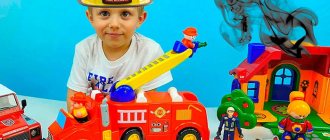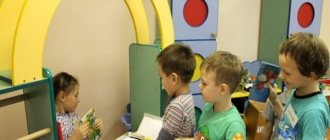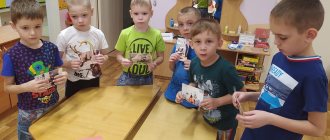How are role-playing games beneficial for a child’s development?
The benefits of such activities are varied. They are as follows:
- creating communicative and speech experience;
- enable the child to act in conditions reminiscent of real situations;
- opening up the chance for exploration and experimentation;
- help to gain social skills from communicating with children and adults;
- by trying on an unusual role, the baby will better understand those around him;
- promote knowledge of different cultures, expression of thoughts and feelings in the most friendly atmosphere;
- provide an opportunity to learn better through entertainment;
- stimulate imagination and creative skills.
Role-playing games are one of the effective language learning techniques. During the course, the baby copies the phrases he hears and can also form his own sentences. This technique promotes the development of vocabulary and experience of communicating with other people.
Features and content of role-playing games for children
This form of entertainment is based on the presence of a certain plot. The meaning of such events is to represent the sphere of reality reproduced by children. Children's role-playing games are quite varied. They depend on the living conditions of the tiny person.
Children 2-3 years old
At this age, role-playing play is just being formed. Due to his young age and psychological characteristics, imperfect speech, the child is still unable to fully communicate with other people. For this reason, his parents are often his companions in the game.
The first role-playing events copy the behavior of the elders in the family. The baby watches how his mother takes care of the household, his serious father works, his grandparents do something in the kitchen and workshop, his brothers and sisters do their homework. Over time, the child begins to independently play in the profession. Most often he is reincarnated as a cook, doctor, salesman, or kindergarten teacher.
Children from 3-4 to 5 years old
The basis of role-playing games for preschool children is an invented situation. It involves the child trying on the role of an adult and performing it in an imaginary environment. Becoming a doctor, the baby pretends to be a doctor who sees a patient.
The entertaining form allows the child in such an imaginary situation to reproduce a variety of role-playing activities and functions that attract him, as well as to join in various events. Through play, the baby becomes what he wants to be.
During entertaining activities, the baby receives help in processing the impressions received from the environment. Against this background, the peculiarities of thinking, imagination of a little person, his emotional background, and activity are clearly expressed.
Senior preschoolers and first graders
The purpose of organizing such events for children in the graduating group of kindergarten is to help in the diversified development of pupils in an imaginary situation. Through play, important personal qualities are developed, and mental abilities are also improved. Children at this age become more proactive.
Five-year-old children can already agree among themselves about the options for the game and its plot. In the imaginary space, all involved participants learn to perform various professional competencies.
Children at play
It is interesting to observe how the nature of the role that a child assigns to himself and his play partners changes from a younger age onwards. At first, the baby performs the actions that parents usually perform with him - wash him, undress him, dress him, put him to bed. He does not imagine himself, say, as a mother, but he copies her movements.
Next comes voice acting - the kids speak instead of the dolls. And only later do they name the roles they take on: I am a mother, I am a daughter, I am a dog. Preschoolers no longer only adhere to the logic of actions, but also demonstrate an understanding of the meaning of social relationships.
At this stage, emotional clashes between children during the distribution of roles are possible. It is imperative that we, adults, stop conflicts and teach children to fairly choose and assign roles. You can show them how to solve the problem of choice using a counting rhyme or lot.
What if we started a discussion on this topic? I have long wanted to have scientific debates with colleagues! Please express “smart” thoughts, valuable comments, and unique suggestions!
You can even subscribe to new materials, and don’t forget to share links to your favorite articles.
Sincerely, Tatyana Sukhikh
See you!
By the way, I recommend reading:
Types and examples of children's entertainment
Role-playing games are one of the important components of children's development. Activities like these help stimulate better imagination. Pretense or artistic play becomes a significant component of children's development.
“Mothers and daughters” and other emotionally charged activities
With the help of such entertainment, a child can form a clear social model of behavior in a team. For example, instill in girls the maternal instinct and mechanisms for handling the future newborn. In addition, the event helps to develop communication experience to the fullest.
In the same category are emotional games that evoke experiences that are not yet available: raising children, adult family relationships. It is worth showing the kids your own example: pick up a doll, kiss it, then lull it to sleep. My daughter will quickly learn to repeat such actions. It is useful for the smallest babies to demonstrate body parts on the baby doll.
“School”, “hospital”, “shop”, other situational actions
These activities are often accompanied by the use of special props: toy cash registers, money, doctor’s kits. In addition to modeling behavior and forming reactions to different formats of situations, an understanding of the functionality of additional props is developing. While playing with your baby, adults need to be shown how to count money correctly. For example, teach how much is fifty and ten, what “money” the buyer needs to return as change.
"Behavior Rehearsal"
This event is a simulation of an incident or an imaginary situation, the repeated experience of which will help to gain some experience in the game. “Rehearse” your child’s upcoming birthday, remembering the mistakes of the past holiday. You can imagine a “mock zoo” after returning from a real event. Such pastime allows you to get rid of psychological stress, it is often used to cause “re-experiencing” both positive and negative emotions. After this, it is easier to analyze the events and help the baby overcome stress (during the course of this game, it is advisable to ask the baby leading questions).
When a child is scared by an animal at the zoo, then re-experiencing a similar situation with a rubber animal will help get rid of the fear. For small children, repeating certain activities is suitable: rocking the child, turning the steering wheel. Help your baby and set an example by doing it several times to reinforce it.
Theater and masquerade
One of the most favorite games for children is stage dressing. This is explained not only by the inclusion of adults in the entertainment, but also by the approach of a favorite holiday (birthday, New Year, May Day). A costume performance will help you fully “fit into” the role, as well as gain admiration from your surroundings, as well as a feeling of “anonymity.” This will rid the baby of phobias and complexes, he will be more relaxed, since he is wearing a mask and no one will be able to recognize him.
Role-playing games are important in the development of children - they form a significant part of training and upbringing. Such events help to better strengthen the imagination and practice various skills. Children enjoy learning about the world through fun because communication allows them to exchange ideas. Through such games, the baby imagines himself in the future.
Methodological principles for organizing role-playing games in age groups
Methodological principles for organizing role-playing games in age groups
Many teachers and psychologists have studied the characteristics of preschoolers’ role-playing games: Elkonin D.B., Vygotsky L.S., Mendzheritskaya D.V., Venger L.A., Mukhina V.S., Vasilyeva M.A., Shcherbakova E.I., Ruskova L.V., Korotkova N.A. Matskevich M., Novoselova S.L.
Role-playing creative games are games that children themselves come up with. Games reflect the child’s knowledge, impressions, and ideas about the world around him, and social relationships are recreated. Each such game is characterized by: theme, game concept, plot, content and role.
In games, the child not only reflects the life around him, but also rebuilds it, creates the desired future.
The game cultivates interest and respect for the work of adults: children portray people of different professions and at the same time imitate not only their actions, but also their attitude towards work and people. Often the game serves as an incentive to work: making the necessary attributes, designing.
The necessary elements that ensure interesting play activities, the development of cognitive interests and moral qualities of a child are knowledge - action - communication
. A special role in this case belongs to the teacher. It is on his personality, knowledge, skills, professional skills and ability to creatively manage play activities that the use of them for the comprehensive development of the child’s personality depends.
So, the first condition for play as an exciting activity is that the child has knowledge about the objects around him.
(about their properties, qualities, purpose),
events and phenomena of the real world
.
The creative nature of play activity is manifested in the fact that the child is, as it were, reincarnated into the person he is portraying, and in the fact that, believing in the truth of the game, he creates a special play life and is sincerely happy or sad as the game progresses.
The creative nature of a role-playing game is determined by the presence of a plan in it, the implementation of which is associated with the active work of the imagination, with the development of the child’s ability to reflect his impressions of the world around him.
The plot-role-playing game has its own specific structure
. This structure includes the following components: plot, content, role.
Plot
- the main component of a plot-role-playing game, without it there is no plot-role-playing game itself. The plots of the games reflect the specific living conditions of the child. They change depending on these specific conditions, along with the expansion of the child's horizons and familiarity with the environment. At the same time, his game actions are one of the main means of realizing the plot.
Contents of the role-playing game
- this is what is reproduced by the child as the main thing in human relationships. The content of the game expresses a more or less deep penetration of the child into the relationships and activities of people. It can only reflect the external side of human behavior - only what and how a person acts, or a person’s relationship with other people, or the meaning of human activity. The specific nature of the relationships between people that children create in the game can be different and depends on the relationships of real adults surrounding the child. A game with the same plot can have completely different content. The social conditions in which a child lives are determined not only by the plot, but, above all, by the content of children's games.
Role for a child
- this is his playing position: he identifies himself with some character in the plot and acts in accordance with ideas about this character. Every role contains its own rules of behavior, taken by the child from the surrounding life, borrowed from relationships in the adult world. For preschoolers, a role is a model of how to act, this is how the child evaluates the behavior of the participants in the game, and then his own.
Conditions under which a child can take on a role: a child takes on a role only if the sphere of reality, which is reflected in the plot of the game, is already familiar to the child. Familiarity with reality is the main condition for the emergence of a role-playing game; acquaintance with this reality must take place in such a way that a person and his activity stand at the center of it. Thus, the basis of the role-playing game is an imaginary situation, which consists in the fact that the child takes on the role of an adult and performs it in a play setting. The game really introduces the child into the world of adults that is so attractive to him, the system of relationships that exists in this world.
Role-playing game in its developed form, as a rule, is of a collective nature. This doesn't mean children can't play alone. But the presence of children's societies is the most favorable condition for the development of role-playing games.
Features of role-playing games:
- Compliance with the rules (the rules follow from the very essence of the game).
- The social motive of games (game is an opportunity for a child to find himself in the world of adults, to understand the system of adult relationships himself).
- In a role-playing game, emotional development occurs (the child distinguishes the game from reality; the speech of preschoolers often contains the following words: “as if,” “make believe,” “in truth,” but despite this, play experiences are always sincere. The child does not pretends. With the complication of the game and the game plan, children’s feelings become more conscious and complex. Role-playing game is a school of feelings, in it the child’s emotional world is formed).
- During the course of role-playing games, the preschooler’s intellect develops.
- In plot-based role-playing games, imagination and creativity develop (planning and coordination of actions in long games are combined with improvisation, children outline a general plan, a sequence of actions, and during the game new ideas and new images arise).
- Speech development.
Types of role-playing games:
- Games with everyday themes: “home”, “family”, “holidays”, “birthdays”. In these games, games with dolls occupy a large place, through actions with which children convey what they know about their peers, adults, and their relationships.
- Games on industrial and social topics that reflect people's work. For these games, themes are taken from the surrounding life (school, store, library, post office, hairdresser, hospital, transport, factory..)
- Games on heroic and patriotic themes, reflecting the heroic deeds of our people (war heroes, space flights)
- Games on themes of literary works, cinema, television and radio programs: “sailors” and “pilots”, Hare and Wolf... In these games, children reflect entire episodes from literary works, imitating the actions of the heroes, the conditions of their behavior.
- “Director’s” games in which the child makes puppets speak and perform various actions. At the same time, he acts both for himself and for the doll.
Guidance of role-playing games for children of senior preschool age
In order for the game, having emerged, to move to a higher stage of development, it is necessary to organize it competently. The teacher must know the peculiarities of organizing play in a children's group.
The term "game management"
In the pedagogical literature on preschool education, denotes a set of methods and techniques aimed at organizing specific games for children and mastering their gaming skills.
The management of role-playing games for preschool children assumes that the teacher influences the expansion of the themes of these games, enriches the content, and promotes children’s mastery of role-playing behavior
.
Thanks to the interconnection of all components, the game from its first stages is organized as an independent activity of children. Gradually she becomes more and more creative and self-developing. The main components of an integrated approach to the formation of a game are preserved at all stages of its development. Only the role of each component changes. All components are important to move the game to a more difficult stage. The role of each of them changes depending on the level of development of the game at a given stage.
When leading role-playing games, educators are faced with the following tasks:
• development of games as an activity (expanding the themes of games, deepening their content);
• using the game for the purpose of educating children's groups and individual children.
The teacher must direct the game without disturbing it, and maintain the independent and creative nature of the game activity.
When guiding role-playing games in older preschool age, the following techniques are used:
Direct Leadership Techniques
- Inclusion of the teacher in the game, taking on a role (main or secondary) - not often, as necessary (showing a speech sample, collective discussion of the role behavior of the players after the game).
Indirect Leadership Techniques
– enriching children’s social experience through all types of activities (observations, excursions, reading fiction, watching children’s TV shows, conversations)
— involving children in the production of attributes and design of playing fields.
Creating conditions for the development of creative role-playing games:
- creation of an object-based play environment (thematic play corners, typical for younger and middle ages - “Hospital”, “Barbershop”, where play equipment and toys are located in a characteristic way, are not typical for older age);
— arrangement of various gaming materials in butts (boxes, containers, drawers with conventional and realistic toys and attributes;
- inclusion of “semi-finished toys” into the environment for making homemade products;
— replenishment and enrichment of the gaming environment in accordance with the knowledge acquired in the classroom.
Adult help:
- remember events that are more suitable for the game, establish their sequence, plan the course of the game, the sequence of actions;
— distribute roles, agree on plans;
— assistance in solving game problems, maintaining cognitive interest in the game;
- watching children play;
- direction of children’s plans and actions (advice, hint, question, change in the play environment);
— creation of problematic situations (flexible influence on the concept of the game, plot development, complication of ways of displaying reality);
- create a game situation;
- individual work (the child does not know how to play, you can use the experience of children who play well).
Methods of using role-playing games:
- Game selection.
- Pedagogical development of a game plan.
- Introducing children to the game plan and finalizing it together
- Creating an imaginary situation.
- Distribution of roles.
- Beginning of the game.
- Saving the game situation.
- Ending the game.
Role-playing games for children in the younger group of kindergarten
The first story games of children proceed as games without a role or games with a hidden role. Children's actions acquire a plot character and are combined into a chain that has vital meaning. This chain consists of 2-3 actions repeated many times. (for example, let's build a tower, Children take turns placing cubes on top of each other), and then the chains become more complex (the teacher prepares food on a toy stove - feeds toys - ..., replaces toy dishes with imaginary ones, with sticks instead of spoons ...
The main tasks of leading games in the younger group are:
- Development of enrichment of play actions with toys based on the enrichment of individual play actions.
- Development and enrichment of game plots.
- Forming children’s skills to play side by side, and then together.
One of the main techniques for managing children's games is the participation of the teacher in their games. Playing together with a teacher promotes greater focus and meaningfulness in children’s actions.
As the game is enriched with game actions and a plot emerges, children begin to use words to indicate their role. This should be helped by the teacher’s questions, addressing the child as his character. All this contributes to the development of a role-playing game.
Role-playing games for children in the middle group of kindergarten
Children in the middle group begin to play collective games, which creates the opportunity for rapid development and change in both the theme and content, as well as the structure of the game: from games on everyday topics to games with a labor, production plot, and then to games that depict various social events and phenomena.
Children in the middle group often play several games on different topics at the same time. In such cases, the teacher first helps the children expand their knowledge for 1-2 games, and then gradually move on to deepen the content of others.
The teacher must use a variety of techniques to organize joint play.
Role-playing games for children in the senior group of kindergarten
At this age, games, along with actions, begin to reflect various social relationships and actions (for example, a mother takes care of her son, and not only feeds, dresses, bathes, but also educates him, reads a book to him). It is important for the teacher to teach the child to develop various plots in the game . The teacher offers the child the main role and takes on an additional role for himself.
The main task of managing games for older preschoolers is to develop their independence and self-organization, develop the ability to agree on the theme of the game, distribute roles, outline the main development of the plot, and prepare the game environment. Also, the teacher must enrich the content of the games.
In all groups, the teacher should propose a new topic for the game from time to time. At the same time, the teacher does not impose the topic on the children, but only tries to arouse interest in it.
Role-playing games for children in the preparatory group of kindergarten
The main content of the game is a reflection of the relationships and interactions of adults with each other. The themes of the games can be varied. All role-playing games are of a joint, collective nature.
The game clearly highlights the preparatory stage: distribution of roles, selection of game material, as well as the making of homemade toys together with the teacher. The number of people involved in the game increases to 5-7 people.
Children of the preparatory group have higher demands on the quality of performance of individual roles, which often gives rise to children's dissatisfaction with each other and leads to conflicts. Stable gaming groups also emerge, but at the same time, the formation of closed groups is possible, the participants of which are reluctant to accept “outsiders” into the game. In such cases, it is necessary for the teacher to directly influence the children’s games: by participating in the children’s collusion before the game or talking about the past game, the teacher can assess the behavior of the players. Conversations between the teacher and children should be short and lively. They require the teacher to be able to understand the game plan and comprehend the nature of the role-playing and friendly relationships of the players.





